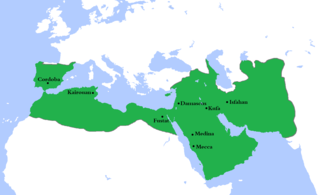
The 8th century is the period from 701 through 800 (DCCC) in accordance with the Julian Calendar.

Year 714 (DCCXIV) was a common year starting on Monday of the Julian calendar. The denomination 714 for this year has been used since the early medieval period, when the Anno Domini calendar era became the prevalent method in Europe for naming years.
The 740s decade ran from January 1, 740, to December 31, 749.
The 720s decade ran from January 1, 720, to December 31, 729.
The 710s decade ran from January 1, 710, to December 31, 719.
The 700s decade ran from January 1, 700, to December 31, 709.
The 630s decade ran from January 1, 630, to December 31, 639.
The 640s decade ran from January 1, 640, to December 31, 649.
The 650s decade ran from January 1, 650, to December 31, 659.
The 660s decade ran from January 1, 660, to December 31, 669.
The 670s decade ran from January 1, 670, to December 31, 679.
The 680s decade ran from January 1, 680, to December 31, 689.
The 690s decade ran from January 1, 690, to December 31, 699.

Year 741 (DCCXLI) was a common year starting on Sunday of the Julian calendar. The denomination 741 for this year has been used since the early medieval period, when the Anno Domini calendar era became the prevalent method in Europe for naming years.

Year 744 (DCCXLIV) was a leap year starting on Wednesday of the Julian calendar. The denomination 744 for this year has been used since the early medieval period, when the Anno Domini calendar era became the prevalent method in Europe for naming years.

Year 713 (DCCXIII) was a common year starting on Sunday of the Julian calendar, the 713th year of the Common Era (CE) and Anno Domini (AD) designations, the 713th year of the 1st millennium, the 13th year of the 8th century, and the 4th year of the 710s decade. The denomination 713 for this year has been used since the early medieval period, when the Anno Domini calendar era became the prevalent method in Europe for naming years.

Year 641 (DCXLI) was a common year starting on Monday of the Julian calendar. The denomination 641 for this year has been used since the early medieval period, when the Anno Domini calendar era became the prevalent method in Europe for naming years.

Year 721 (DCCXXI) was a common year starting on Wednesday of the Julian calendar. The denomination 721 for this year has been used since the early medieval period, when the Anno Domini calendar era became the prevalent method in Europe for naming years.

Al-Walid ibn Abd al-Malik ibn Marwan, commonly known as al-Walid I, was the sixth Umayyad caliph, ruling from October 705 until his death in 715. He was the eldest son of his predecessor, Caliph Abd al-Malik. As a prince, he led annual raids against the Byzantines from 695 to 698 and built or restored fortifications along the Syrian Desert route to Mecca. He became heir apparent in c. 705, after the death of the designated successor, Abd al-Malik's brother Abd al-Aziz ibn Marwan.
al-ʿAbbās ibn al-Walīd ibn ʿAbd al-Malik was an Umayyad prince and general, the eldest son of Caliph al-Walid I. He distinguished himself as a military leader in the Byzantine–Arab Wars of the early 8th century, especially in the Siege of Tyana in 707–708, and was often a partner of his uncle Maslama ibn Abd al-Malik during these campaigns. He or his father are credited for founding the short-lived city of Anjar in modern Lebanon.









